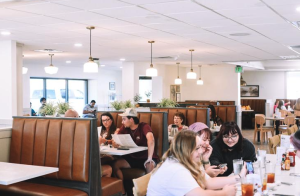Many concepts are experimenting with renovations and new prototype designs in order to maximize profits and efficiency for franchisees. In the case of Mooyah Burgers, Fries and Shakes, the focus for its prototype is takeout.
“I primarily like to approach it as ‘consumer first,’ and then obviously operationally we need to deliver a great consumer experience,” said Doug Willmarth, president of Mooyah. “Most restaurant companies are always thinking about, ‘how do we improve our spaces?’”
During his years in the industry, Willmarth has seen trends come and go. Before joining Mooyah in 2021 he was chief brand officer for Genghis Grill parent Mongolian Concepts and did stints at Chili’s, Pizza Hut and Wingstop, with much of his experience involving brand innovation and marketing.
“When I got here, we were building the same model in 2021 as we were in 2019,” said Willmarth, “and the world had clearly changed.”
Mooyah’s prototypes have smaller dining rooms and broader ordering options, including kiosks. The cooking and holding space will be expanded for takeout. The brand also reduced its footprint to roughly 2,000 square feet, down from 2,400 to 2,700 square feet.
BBQ Holdings, the owner of Famous Dave’s and Village Inn, has also been experimenting with various prototypes. The revitalization of Village Inn, a casual dining concept, has been a focus.

Village Inn locations are getting a facelift to revitalize the brand while not compromising the core of the concept.
“We saw an opportunity to modernize the brand a little bit and also draw in a different consumer,” said Al Hank, chief operating officer of BBQ Holdings.
The goal is not to completely change the aesthetic of the brand but to give it a refresh with updated color schemes and signage, while not totally departing from the core look.
“It’s clean, it’s neat and it’s timeless,” said Hank. “But so far, consumer feedback has been incredible.”
Looks aren’t the only update. Coffee grew in popularity in the 60 years Village Inn has been open, so adding a full-service coffee machine was a must. The brand is even testing full-service bars.
When it comes to choosing what to change and what to leave, Hank keeps the brand itself in mind for decisions.
“I think the key is making sure you don’t deviate too far away from what the core of the brand is,” said Hank. “Certainly, people want to try and test things, but I think people go wrong when they change the root core of the concept and push the boundary too far.”
For both concepts, these smaller and combined spaces offer a secondary benefit: lower costs. Building out in smaller spaces often means reduced rental costs, and the restaurants require fewer workers. Construction costs, top of mind for operators amid broader inflation concerns, can also be reduced.
“Equipment costs a lot more, rents are up, it costs more to build a location and everybody’s labor is more,” said Willmarth. “Anything we can do in asset design to improve the ROI for our franchisees, who are our business people, we want to make sure that the costs are proportional to the sales you get out of it.”
Mooyah and Village Inn are far from the only concepts offering new designs. Jim Balis, managing director of strategic operations at institutional investor CapitalSpring, has watched the restaurant space adapt to new trends for years now, and a few patterns did emerge.
“Restaurant companies, as a whole, are trying to remain competitive, evolve themselves, and the evolution comes in different forms,” said Balis. “One form is aesthetics and design. Another form is technology and automation, and another form is cost engineering.”
At the end of the day, lower costs and better return on investment is the goal. Franchisors need to hit the sweet spot of attracting franchisees and ensuring their success with consumers when it comes to making these prototypes.

Village Inn is also finding its space in dual-concept locations, allowing franchisees to capitalize on two brands for one space.
Trends in the industry depend on the restaurant type, said Balis, who is also CEO of Sizzling Platter, the operating arm of CapitalSpring with more than 600 units in brands such as Little Caesars and Wingstop.
“For full-service brands, you’re definitely seeing a remodel or new design prototype that includes areas that are designated for carryout,” said Balis. “In the quick-serve space, it’s a lot around looking at your business and saying, ‘I have 60 or 80 seats. Maybe I only need 12 or 15.’”
Some restaurants are really thinking outside the box. As robotics become more popular, automation technology is often part of the prototype conversation. Even facial recognition is being utilized as part of the ordering process in the name of efficiency, Balis said.
In his estimate, brands invest between $60,000 to $500,000 for these types of renovations, depending on various factors. And likely the industry is only going to see more and more ideas appear in the coming years.
“The thing to think about is how often does a restaurant need to be remodeled,” said Balis. “The answer is very difficult because it really does vary.”


